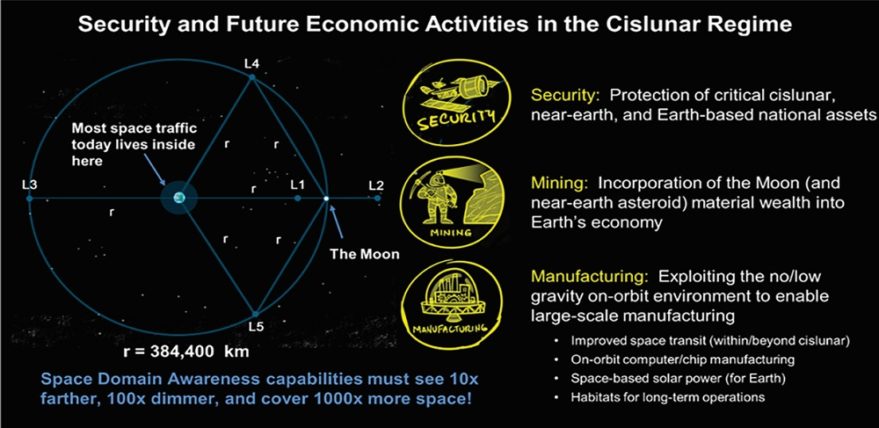
Exploitation of the space domain is driving profound changes in U.S. national security and economic strategy. As military and economic activity expands beyond GEO, so too will the associated challenges of space debris, flight safety, and security. The U.S. Space Force, in their recently published capstone document Spacepower, put it this way: “Today, the entirety of economic and military space activities is confined to the geocentric regime; however, commercial investments and new technologies have the potential to expand the reach of vital National space interests to the cislunar regime and beyond in the near future.”
Protecting U.S. and allied activities in cislunar space presents significant technological challenges that must be surmounted to ensure U.S. preeminence in the cislunar regime. The figure below provides an overview of the scale (1,000 times the volume of GEO) and scope (potentially $10 trillion economy) of the cislunar regime, which contains the Earth, moon, and Lagrange points where spacecraft may perform many of the future functions within a cislunar economy.
Our vision for American leadership in cislunar space combines commercial and government capabilities focused on achieving U.S. cislunar information dominance. Extending commercial solutions to ensure precise and persistent cislunar space domain awareness (SDA) holds great promise for mitigating challenges inherent to this domain. This way forward requires a close partnership among industry and government organizations.
Cislunar information dominance can be defined as the ability to seize and control the information domain “high ground” when, where, and however required for decisive competitive advantage across the range activities within cislunar space. Commercial solutions exist or are in development across a spectrum of activities once exclusively reserved for governments, from communications to navigation to lunar landing.
Cislunar SDA technologies are a foundational component of the infrastructure needed to support a cislunar economy, yet they have not received the priority or resources commensurate with their importance. The U.S. government must commit to ensuring that commercial solutions for cislunar SDA achieve the required performance to support future operations and thereby assuring the United States maintains its freedom of action and technological advantage in this vast region. Persistent, sensitive, timely, and accurate cislunar SDA is a critical enabler of cislunar information dominance and underpins future U.S. space security and economic competitiveness.
Beijing has long-term plans to be the preeminent spacefaring nation by 2045. China sees itself as entitled to control space the same way it feels entitled to control the South China Sea. The United States cannot allow China to treat the moon and its strategic Lagrange points like islands in the South China Sea. The Chinese define “information dominance” (zhi xin quan) as the ability to gather, transmit, analyze, and exploit information more rapidly and more accurately than the adversary, and preventing the adversary from doing the same. They understand that a critical component of the strategic competition in cislunar space will be maintaining an advantage in SDA capability.

A vision for U.S. leadership in cislunar space
The stakes in the quest for leadership in cislunar space are high, given the growing economic and political-military competition between the U.S. and China. The U.S. must be able to understand what is happening in cislunar space 24/7/365 to avoid surprise and enable effective U.S. commercial and governmental cislunar operations. By leveraging leading U.S. commercial SDA companies and making modest, targeted investments in cutting-edge SDA technologies, the U.S. government can help enable effective cislunar SDA capabilities.
Assuring U.S. freedom of action in space demands a prioritized national effort to effectively plan for sustained operations in cislunar space. We must evolve our current thinking from an academic exercise pondering possible distant futures and accelerate action to outpace our primary competitor in cislunar space. America has some strong advantages in this competition, including a vibrant commercial New Space economy and strong technical accomplishments, including in commercial SDA. Commercial SDA companies possess high performance capabilities which can and should be leveraged to support cislunar applications. Commercial SDA is foundational to achieving a cislunar economy where American values lead the way.
To that end, a public-private sector initiative would enable development, testing and fielding of new concepts and capabilities for space-based cislunar SDA to assure U.S. information dominance in this critical sphere.
Brien Flewelling is chief SSA architect at Exoanalytic Solutions.
This article originally appeared in the Oct. 19, 2020 issue of SpaceNews magazine.
